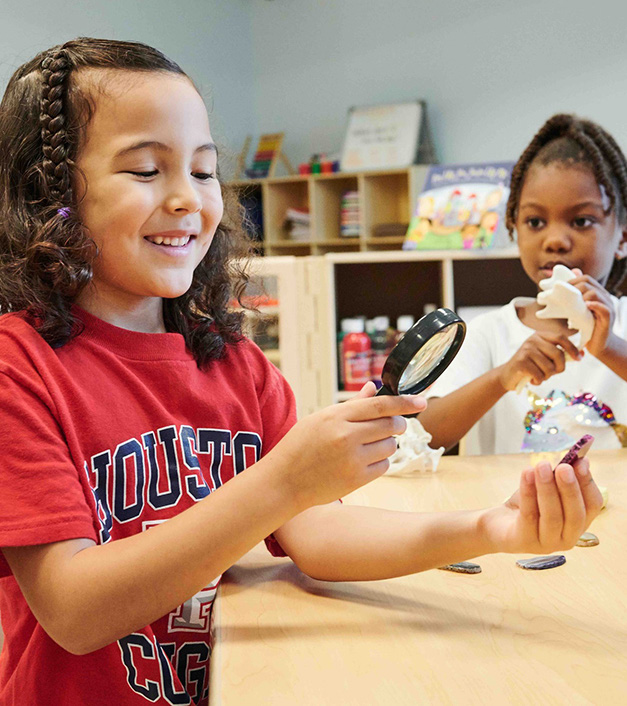Elevating Early Learning and Child Care Quality with YMCA of greater houston
Aldine, Aldine Southeast, Northline, & Northside
HARRIS COUNTY EARLY LEARNING QUALITY NETWORK (ELQN)
COMMUNITY PROFILE
Stay connected! Sign up for ELQN updates.
ABOUT HARRIS COUNTY ELQN
Harris County’s Early Learning Quality Network (ELQN) is a community-centered initiative dedicated to strengthening early learning and child care across the county. Supported by the Harris County Department of Economic Equity and Opportunity, this three-year effort relies on community input and local data to guide its work. This profile highlights the initiative’s progress in Aldine, Aldine Southeast, Northline, and Northside (located in Harris County Precinct 2) through December 2024.
Across Harris County’s four precincts, five communities identified as Child Care Deserts with high social vulnerability are participating in ELQN. Local Network Organizations (LNOs), chosen for their strong ties to these areas, lead efforts to engage child care providers, families, and community members in identifying challenges, priorities, and improvement strategies related to early learning and child care. CHILDREN AT RISK, serving as the Network Support Hub (NSH), provides LNOs with technical assistance and oversees funding for community identified quality-enhancing initiatives. By fostering community collaboration and leveraging local strengths, ELQN demonstrates Harris County’s shared commitment to building a brighter future for our youngest learners.
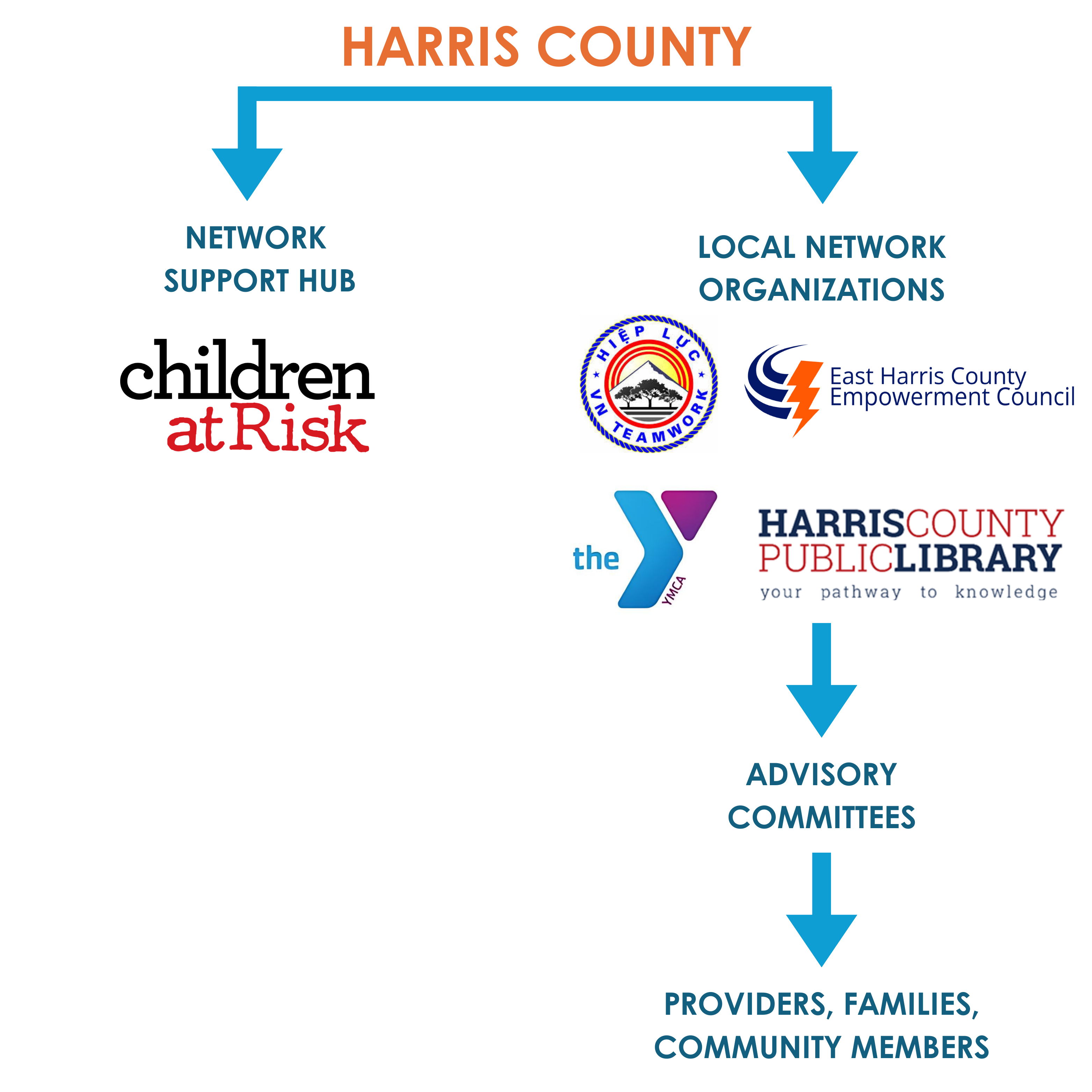
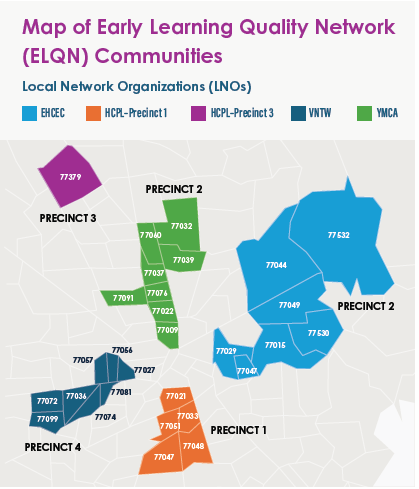
East Harris County Empowerment Council: Precinct 2
Harris County Public Library: Precincts 1 & 3
VN TeamWork, Inc.: Precinct 4
YMCA of Greater Houston: Precinct 2
LNO Spotlight | YMCA of Greater Houston
The YMCA of Greater Houston was selected to coordinate the ELQN initiative in Aldine, Aldine Southeast, and Northline. The YMCA remains committed to the health of more than half a million people who learn, grow, and thrive through programs and services at locations across Harris County.
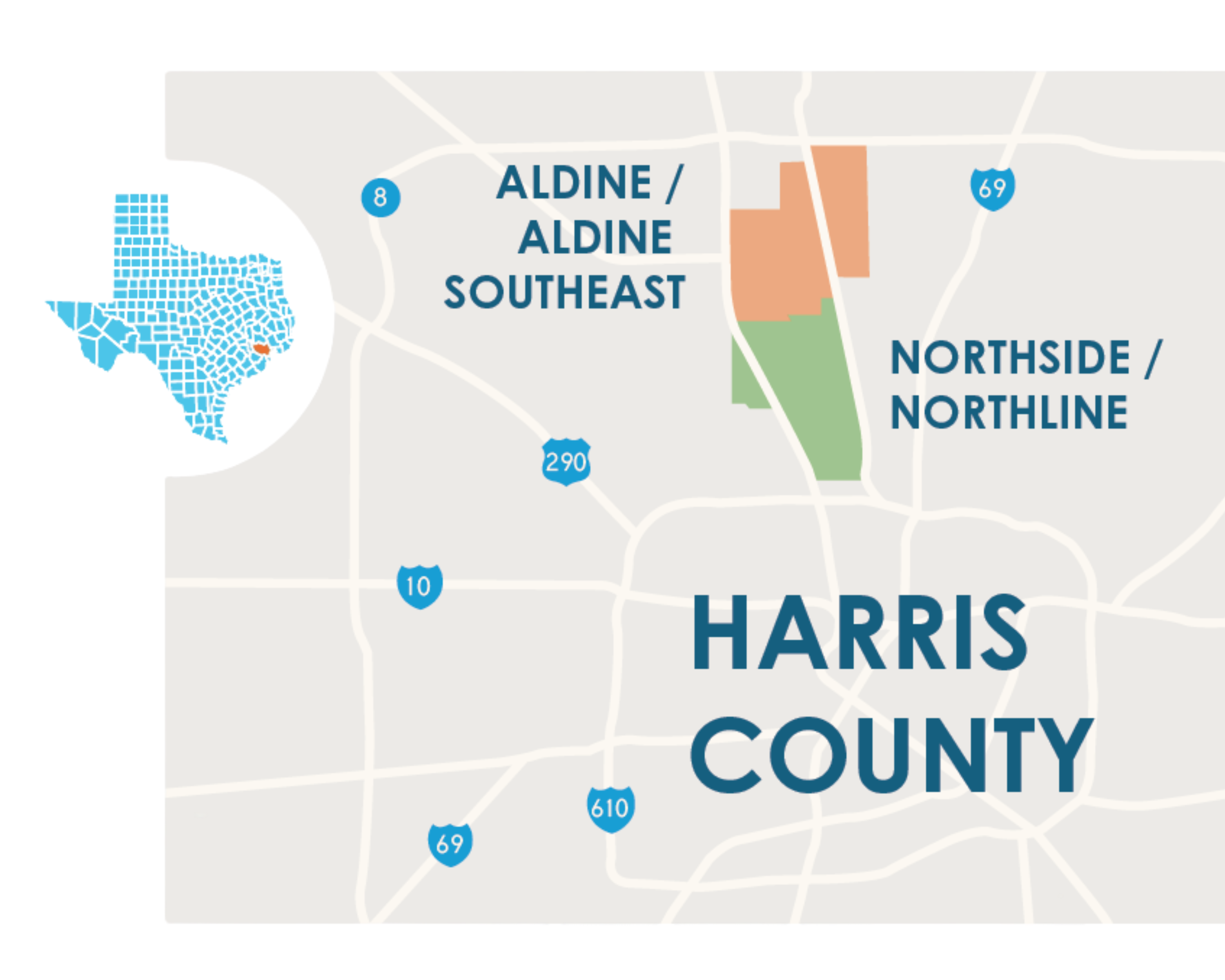
AT A GLANCE
Aldine, Aldine Southeast, Northline, and Northside
Aldine, Aldine Southeast, Northline, and Northside are diverse communities in Harris County, Texas, with
rich histories tied to Houston’s development.
Number of Providers
Estimated Number of Seats
Estimated Children in Need
ALDINE AND ALDINE ISD
Aldine began as a farming community in the late 19th century. It has since grown into a working-class suburban area known for its stron nnection to industry and transportation, given its proximity to major highways and George Bush Intercontinental Airport. Aldine Southeast is a more residential area with a predominantly Hispanic/Latinx population, reflecting the broader demographic trends of the community.
Total Population
%
Population Under Age Five
Median Household Income
Race & Ethnicity
- White 41%
- Black 2.9%
- Hispanic or Latino 87.9%
- AAPI 0.9%
- 2 or More Races 23.7%
- American Indian & Alaskan Native 1.0%
NORTHLINE AND NORTHSIDE
Northline is revitalizing with new developments and community-driven initiatives. These areas maintain a lively, multicultural vibe, with local schools, parks, and locally owned businesses and restaurants that reflect their strong community spirit. The Northside community is a vibrant and diverse area located just north of downtown Houston. The neighborhood has a rich history, and it is home to a mix of residential, commercial, and industrial properties. Northside has a large Hispanic/Latinx population, with many families of Mexican, Central American, and other Latin American origins. This gives the area a unique cultural flavor, evident in its food, festivals, and local businesses. You can find authentic Mexican cuisine, bilingual signage, and community centers celebrating Latino heritage.
Total Population
%
Population Under Age Five
Median Household Income
Race & Ethnicity
- White 6.9%
- Black 8.3%
- Hispanic or Latino 84.2%
- AAPI 0.4%
- 2 or More Races 0.1%
FOSTERING COMMUNITY ENGAGEMENT THROUGH ELQN
To prioritize community voices, LNOs provided residents with many meaningful opportunities to share their ideas on how to improve and expand early learning and child care opportunities within their neighborhoods. In spring and summer 2024, YMCA organized outreach events, focus groups, listening sessions, and town halls to gather input from child care providers, families, and other community members. During this period, residents were also encouraged to apply to the ELQN Advisory Committee, which was responsible for identifying key needs and envisioning what high-quality care could look like in their communities.
The Aldine, Aldine Southeast, Northline, and Northside ELQN Advisory Committee, consisting of four community members, four parents, and representatives from five early learning and child care centers, played an essential role in considering community input, analyzing relevant data (including community surveys), and generating a plan to address local needs while staying aligned with community priorities.
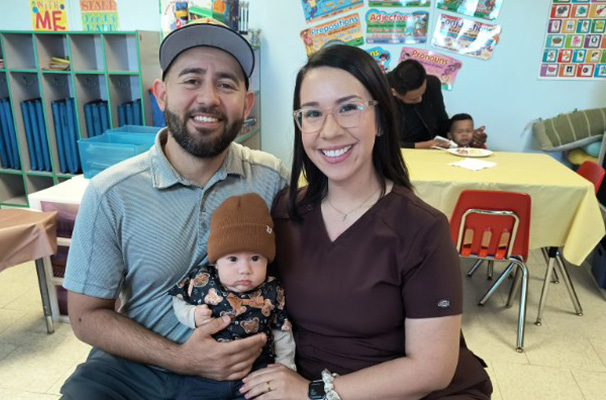

ELQN COMMUNITY CENTERED PLANNING PROCESS
Through this process, the ELQN Advisory Committee identified key early learning and child care challenges in the target zip codes. Providers reported financial barriers, infrastructure needs, and a lack of resources to support kids with diverse or enhanced learning requirements, including neurodivergent children. Parents prioritized safety and proximity but often struggled with high costs and inconsistent quality. Community members highlighted the need for increased funding, staff training, and partnerships between schools and child care providers to improve services and accessibility. Despite these challenges, these vibrant, multicultural communities rooted in rich histories and strong community spirit offer a solid foundation for improving early learning opportunities and accessibility.

YMCA STRENGTHENING TIES WITH THE COMMUNITY
YMCA’s outreach for ELQN first involved research into the targeted zip codes, followed by intentionally building connections with early childhood providers, families, and community organizations. As its outreach efforts expanded, YMCA carefully evaluated what was working and adjusted its approach to better meet the needs and preferences of the community.
Initially, outreach incentives such as gift card raffles and Jason’s Deli boxes didn’t resonate with participants. Recognizing this, the team pivoted to offering food from local restaurants instead, which generated more excitement. The team also adjusted their approach to giveaways, shifting from raffles to guaranteed incentives for the first attendees.
As one team member shared, “I noticed that families weren’t really interested. . . If there’s 40 people here, I might get an incentive, I might not.” This change significantly boosted turnout. Through thoughtful adjustments and a commitment to listening, the YMCA strengthened trust and engagement, demonstrating that “just really listening to [the community] and providing what they want has helped a lot.” YMCA’s outreach for ELQN relied on initial research, community engagement, and a responsive, evolving approach. By carefully evaluating what worked and making necessary adjustments, YMCA strengthened its ties with the community, ensuring that its services were meaningful, impactful, and in tune with the needs and preferences of the families and organizations being served.
THROUGH THEIR EYES: AMPLIFYING COMMUNITY VOICES WITH PHOTOVOICE
A child care provider joined the Photovoice project to explore the experiences of families, providers, and community members with early learning and child care in Alief, Sharpstown, Gulfton, Braeburn, and Westwood. She captured photos and shared stories—both her own and those of her neighbors—highlighting community needs, key issues, and opportunities for improvement. Below, she shares her photos and narratives about the community.
THE POWER OF A HUG: HONORING EARLY CHILDHOOD CAREGIVERS
A caregiver embraces a young child in a warm hug. This child, who has been in group care since infancy, deeply trusts his caregiver. With over 10 years of experience in the field and more than five years at this center, the caregiver holds a Child Development Associate (CDA) credential and dreams of continuing her education in early childhood. Moments before, she had read a book about hugging and was teaching the child what a hug means.
Hugging and physical touch are fundamental to human connection. While it was once believed that holding and comforting young children could lead to spoiling and tantrums, research has proven the opposite to be true. Hugs are a simple yet powerful way to comfort a child in distress and foster emotional security.
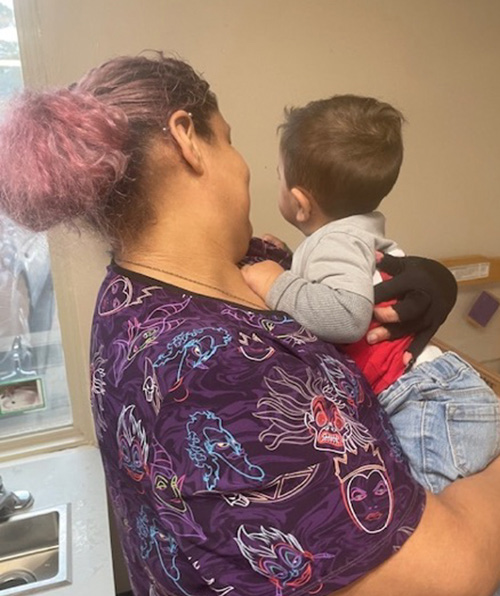
It’s crucial for adults to understand that you cannot spoil a child by holding, hugging, and comforting them. Equally important is the need to recognize and value the work of early childhood professionals. The first three years of life are critical for development, yet they are often overlooked. Early childhood educators, far more than “babysitters,” play a vital role in shaping young lives. It’s time their contributions are acknowledged and their profession receives the respect and compensation it deserves.
-Child Care Provider and Parent
ELQN STRATEGIES TO ENHANCE EARLY LEARNING AND CHILD CARE QUALITY
After identifying and prioritizing the early learning and child care needs of the community, the ELQN Advisory Committee submitted a Child Care Quality Action Plan (CCQAP) to Harris County and CHILDREN AT RISK. This plan included quality improvement strategies that aligned with community needs. After a feasibility review by Harris County, strategies were finalized in late 2024. Identification of needed resources began in late 2024, with implementation scheduled to take place throughout 2025 and 2026.

Child Care Quality Action Plan (CCQAP)
The CCQAP was developed by LNO staff and the ELQN Advisory Committee to address the key needs identified in each community. Drawing on community input and local data, the plan outlines actionable strategies to be implemented in collaboration with the county to meet these needs effectively.
TURNING NEEDS INTO ACTION: ELQN STRATEGY GUIDE
COMMUNITY IDENTIFIED NEED
Affordability programs such as subsidies and other resources for families to use at licensed centers and home providers
Emergency and Temporary Care
This strategy will help families with young children afford child care during tough times, such as after a job loss, during an emergency, or while waiting for assistance from other programs. Families will apply through local child care centers, which will partner with the program to provide temporary care. The program will pay centers directly, ensuring both families and providers receive the support they need in a timely manner.
COMMUNITY IDENTIFIED NEED
Safety and Equipment such as closed-circuit cameras, sensors, and essential safety equipment to enhance safety measures in licensed early learning and child care centers
Facility, Safety, and Security
This strategy will help child care centers and homes improve their facilities, safety, and security. Providers will apply to receive upgrades like new furniture and outdoor play equipment, or safety equipment such as cameras and childproofing items. Programs will be provided with customized items tailored to their needs and support for installation.
COMMUNITY IDENTIFIED NEED
Access to Quality Care and Resources to increase parental involvement to ensure all children have the support they need to succeed, including children with special needs
Technology – Household
This strategy will provide qualifying households with developmentally appropriate technological learning tools and training related to the use of technology with young children.
COMMUNITY IDENTIFIED NEED
AAccess to Quality Care and Resources to increase parental involvement to ensure all children have the support they need to succeed, including children with special needs
Technology – Childcare
This strategy provides child care providers with improved technological resources aimed at enhancing early childhood development and improving the efficiency of business operations
COMMUNITY IDENTIFIED NEED
Access to Quality Care and Resources to increase parental involvement to ensure all children have the support they need to succeed, including children with special needs
Training and Professional Development
Training and professional development programs will help parents, caregivers, and child care workers in Harris County gain skills to support young children’s growth and learning. Training on topics like child development and creating inclusive, welcoming environments will be offered free of charge. Participants will also receive resources, coaching, and stipends.
ABOUT THE ELQN EVALUATION
The ELQN evaluation seeks to understand the planning and design, implementation, and community impact of the initiative over three years. Using diverse data sources—including community storytelling through photographs and narratives, interviews, focus groups, and surveys—the evaluation will provide actionable information on this community-centered initiative, documenting lessons learned along the way. The findings will enhance Harris County’s ability to serve young children and their families.
Engage with ELQN
Join us in our mission to make a lasting impact across Harris County.
Stay Connected
Follow @childrenatrisk on social media and subscribe to our newsletter to stay updated on our progress and learn more about how ELQN is making a difference in early learning across Harris County.
ACKNOWLEDGEMENTS
AUTHORS
Lisa Lopez-Escobar
Kate McKenney, EdD
Sherylls Valladares Khan, PhD
CONTRIBUTORS & REVIEWERS
Harris County Department of Economic Equity & Opportunity
CHILDREN AT RISK
East Harris County Empowerment Council (EHCEC)
EDITING
Cathy Cambron, Editcetera
DESIGN
Danielle Ness, Hey Darlin’
